Bifurcation in a Discrete Competition System
Abstract
A new difference system is induced from a differential competition system by different discrete methods. We give theoretical analysis for local bifurcation of the fixed points and derive the conditions under which the local bifurcations such as flip occur at the fixed points. Furthermore, one- and two-dimensional diffusion systems are given when diffusion terms are added. We provide the Turing instability conditions by linearization method and inner product technique for the diffusion system with periodic boundary conditions. A series of numerical simulations are performed that not only verify the theoretical analysis, but also display some interesting dynamics.
1. Introduction
The discrete time models governed by difference equation are more realistic than the continuous ones when the populations have nonoverlapping generations or the population statistics are compiled from given time intervals and not continuously. Moreover, since the discrete time models can also provide efficient computational models of continuous models for numerical simulations, it is reasonable to study discrete time models governed by difference equations.
Although numerical variations of system (1) have been extensively studied (see, e.g., the work in [5–8]), some discrete analogs may be found in [9–15], regarding attractivity, persistence, global stabilities of equilibrium, and other dynamics. Up to now, to the best of our knowledge, the discrete system (4) has not been investigated.
In this paper, we will study the dynamical behaviors of models (4), (5), and (6). By using the theory of difference equation, the theory of bifurcation, and the center manifold theorem we will establish the series of criteria on the existence and local stability of equilibria, flip bifurcation for the system (4). For the one- or two-dimensional diffusion systems, with periodic boundary conditions, the Turing instability (or Turing bifurcation) theory analysis will be given. Turing instability conditions can then be deduced combining linearization method and inner product technique. Furthermore, by means of the numerical simulations method, we will indicate the correctness and rationality of our results.
The paper is organized as follows. In Section 2, we study the existence and stability of equilibria points and the conditions of existence for flip bifurcation are verified for system (4). Turing instability conditions will be illustrated by linearization method and inner product technique for the system (5) and (6) with periodic boundary conditions in Section 3. A series of numerical simulations are performed that not only verify the theoretical analysis, but also display some interesting dynamics. For the system (4), the bifurcation diagrams are given. The impact of the system parameters and diffusion coefficients on patterns can also be observed visually for the given diffusion systems. Finally, some conclusions are given.
2. Analysis of Equilibria and Flip Bifurcation
- (1)
if |λ1| < 1 and |λ2| < 1, then steady state E is called a sink and E is locally asymptotically stable;
- (2)
if |λ1| > 1 and |λ2| > 1, then E is called a source and E is unstable;
- (3)
if |λ1| > 1 and |λ2| < 1 (or |λ1| < 1 and |λ2| > 1), then E is called a saddle;
- (4)
if either |λ1| = 1 and |λ2| ≠ 1 or |λ2| = 1 and |λ1| ≠ 1, then E is called nonhyperbolic.
Case 1 (the fixed point E0 = (0,0)). The linearization of (4) about E0 has the Jacobian matrix
Case 2 (the fixed point E1 = (0, r)). At the fixed point, the Jacobian matrix has the form
Case 3 (the third fixed point E2 = (r, 0)). The linearization of (4) about E2 has the Jacobian matrix
Case 4 (the fixed point E3 = (r/(a + 1), r/(a + 1))). The linearization of (4) about E3 has the Jacobian matrix
- (1)
|λ1| < 1, |λ2| < 1 if and only if 0 < r < 2, 0 < a < 1;
- (2)
λ1 = −1, |λ2| ≠ 1 if and only if r = 2, a ≠ 1;
- (3)
λ2 = 1, |λ1| ≠ 1 if and only if a = 2, r ≠ 2;
- (4)
λ2 = −1, |λ1| ≠ 1 if and only if a = (r − 2)/(r + 2), r ≠ 2;
- (5)
|λ1| < 1, |λ2| > 1 if and only if 0 < r < 2, a > 1;
- (6)
|λ1| > 1, |λ2| < 1 if and only if 2 < r < (a + 1)/(a − 1);
- (7)
|λ1| > 1, |λ2| > 1 if and only if r > 2, a > 1.
The following theorem is the case that the fixed point E3 is a flip bifurcation point.
Theorem 1. The positive fixed point E3 undergoes a flip bifurcation at the threshold rF = 2.
Proof. Let ζn = un − u*, ηn = vn − v*, and μn = r − 2, and parameter μn is a new and dependent variable; the system (4) becomes
Let
By the following transformation:
3. Turing Bifurcation
In this section, we discuss the Turing bifurcation. Turing′s theory shows that diffusion could destabilize an otherwise stable equilibrium of the reaction-diffusion system and lead to nonuniform spatial patterns. This kind of instability is usually called Turing instability or diffusion-driven instability [16].
3.1. One-Dimensional Case
Thus, the following fact can be obtained.
Proposition 2. If is a solution of the problem of (30) and (31), then
Proposition 3. If there exist positive numbers d1, d2 and the eigenvalue λs of the problem (33)-(34) such that one of the conditions
For the system (5), we have the following results about instability of the positive equilibrium of system.
3.2. Two-Dimensional Case
The following theorem will show that the system (47) also undergoes Turing instability. Since the analysis is very similar to the one-dimensional case, the proof is omitted.
4. Numerical Simulation
As is known to all, the bifurcation diagram provides a general view of the evolution process of the dynamical behaviors by plotting a state variable with the abscissa being one parameter. As a parameter varies, the dynamics of the system we concerned change through a local or global bifurcation which leads to the change of stability at the same time.
Now, r is considered as a parameter with the range 0.5–3.5 for the system (4). Since the bifurcation diagrams of r − ut are similar to the bifurcation diagrams of r − vt, we will only show the former which can be seen from Figure 1.
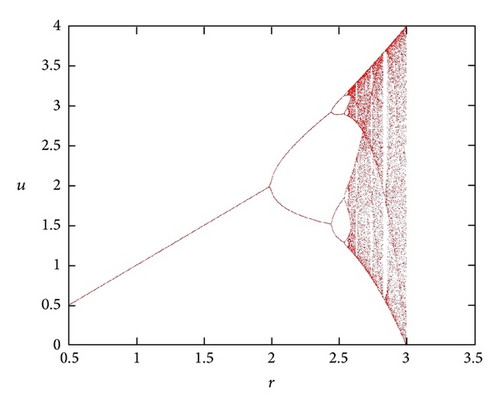
Next, we performed a series of simulations for the reaction-diffusion systems, and, in each, the initial condition was always a small amplitude random perturbation 1% around the steady state. As a numerical example, we consider the bifurcation of the two-dimensional system (47)-(48). It is well known that Turing instability (bifurcation) is diffusion-driven instability; thus the diffusion rate is vital to the pattern formation. To investigate the effect of diffusion coefficients on patterns, by keeping all the other parameters of the system fixed (a = 0.55, r = 0.71, and d1 = 0.22), we change a diffusion coefficient in the Turing instability region (parameter space which satisfies Turing instability). Figures 2(a)–2(f) exhibit in detail the different distribution of patterns with varying values of d. If we let d2 = 0.19, a stable pattern of square shapes, namely, stationary wave, is observed in Figure 2(a). With the increase of d2, some tips appear, which attempt to form self-centered spiral waves (Figure 2(b)). Then some tips vanish and some tend to evolve to regular spiral waves, shown in Figure 2(c). Then, with the parameter evolution proceeding, the size of spiral waves rises, but the density of them decreases (see Figure 2(d)). If d2 is further increased, we observe that, in parts of patterns, spiral waves begin to break up. Hardly can spiral waves be seen, disorder and chaotic structure are depicted in Figures 2(e) and 2(f).
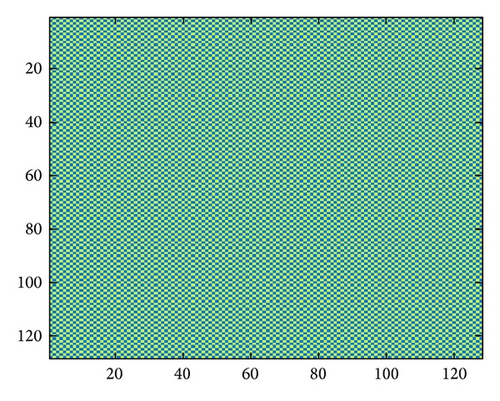
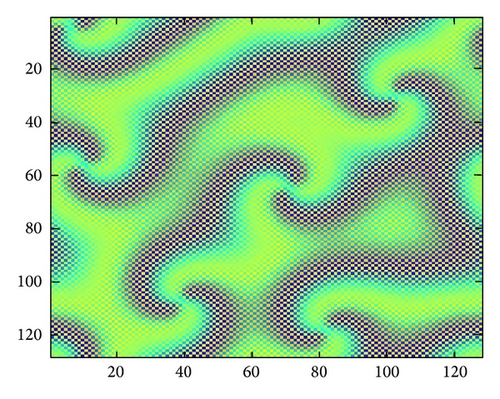
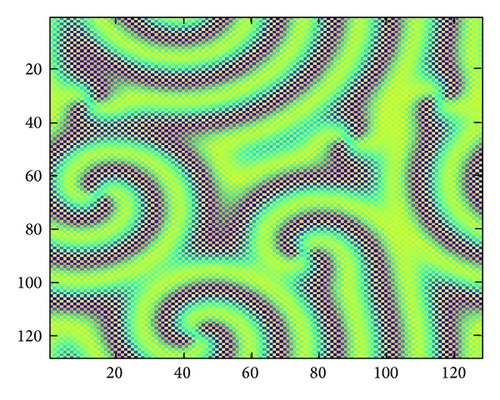
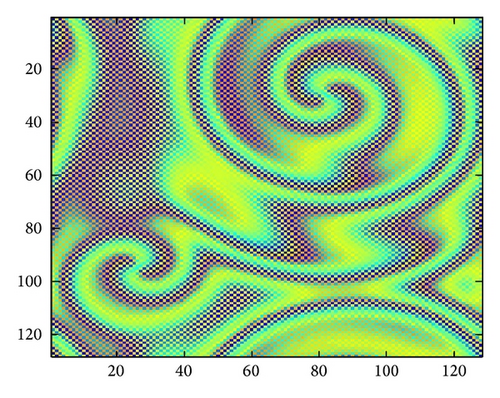
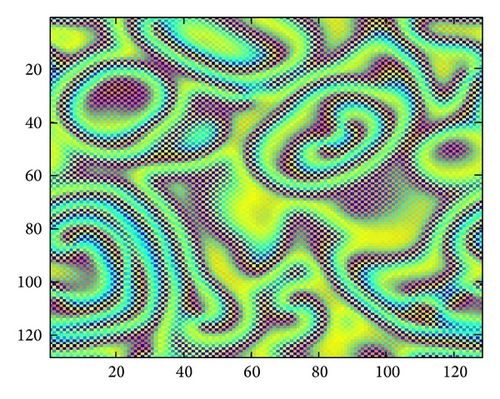

5. Discussion and Conclusion
In this paper, we have applied different discrete schemes to convert the continuous Lotka-Volterra competition model to a new discrete model and studied the dynamical characteristic of the discrete model. Our theoretical analysis and numerical simulations have demonstrated that the discrete competition model undergoes flip bifurcation. Furthermore, when the effects of spatial factors are considered, we discuss the Turing instability conditions combining linearization method and inner product technique. The impact of the diffusion coefficients on patterns can also be observed visually, and some interesting situations can be observed. Indeed, the new discrete model can result in a rich set of patterns and we expect that it is more effective in practice.
Conflict of Interests
The authors declare that there is no conflict of interests regarding the publication of this paper.
Acknowledgments
The authors thank Dr. Y. D. Jiao for the valuable suggestions and thank the referees for their helpful comments. This work was financially supported by Tianjin University of Commerce with the Grant no. X0803, the National Natural Science Foundation of China under Grant nos. 11001072, 11371277, and Cultivation Program for Excellent Youth Teacher in University, Tianjin (507-125RCPY0314).




